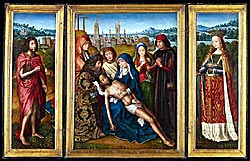
The Elevation of the Magdalen
Peter Strüb the Younger (Master of Messkirch)
16th century
Tempera on panel
The Bergmann Richards Memorial Fund and the Fiduciary Fund
|
Mary Magdalene
It is difficult to establish the real history of Mary Magdalene, who is apparently the conflation of three different women named
Mary who are described in episodes of the New Testament as among the devoted followers of Christ. It is possible, although improbable,
that she was the sister of Martha and Lazarus, who lived in Bethany.1 Mary Magdalene is referred to in Mark's gospel in the Bible's New
Testament as the woman from whom Jesus cast seven devils (16:9). Mark also identifies her as one of three Marys who anoint Jesus' body
after his crucifixion (16:1), and as the first person Jesus sees after his resurrection (16:9). Later traditions identified her as the
unnamed prostitute described in Luke's gospel who was forgiven her sins by Jesus, after she washed his feet with her tears and dried
them with her hair (7:36).2 During the Middle Ages, Mary Magdalene came to exemplify the faithful and repentant sinner. She stood as
a message to Catholic believers that no one, except the devil, is beyond forgiveness and redemption. By 1500, during the age of the
Counter Reformation, pictures of Mary Magdalene came to represent the Roman Catholic Church itself, whose excesses could also be forgiven
through Christ's love. |
|
Saints
During the Middle Ages many legends sprang up about the later life of "the Magdalene," as she came to be called, all without any
factual foundation or Biblical reference. The Elevation legend is one of these. The most influential and widely circulated version of
Mary Magdalene's work, exile, and death was the one recounted in a popular 13th-century collection of stories called The Golden Legend
by Jacobus de Voragine (ja-KOH-bus duh ve-RAJ-i-nee). The Golden Legend was essentially a layperson's version of the lectionaries, or
lives of the saints, which were read on each saint's feast day during the year. As an archbishop of Genoa, Voragine was familiar with
these texts known chiefly to church clerks.3
The saints - the heroes of the Middle Ages and Renaissance - were role models of perfection, possessing divine wisdom, super strength, and
unwavering devotion. These exemplars of Christian virtues frequently appeared in altarpiece paintings, inspiring worshipers to emulate
their behavior.

|
Lamentation with panels of Saint John and Saint Catherine
Master of the Legend of Saint Lucy
Oil on panel, c. 1490
Bequest of John R. Van Derlip in Memory of Ethel Morrison Van Derlip |
The Elevation of the Magdalen
Peter Strüb's (stroob) painting The Elevation Elevation of the Magdalen shows Mary, covered with hair, being lifted up by 14
angels. A golden halo surrounds her idealistically youthful face, which shows no signs of her 30-year stay in the wilderness. Her
abundantly flowing red hair is a common
ATTRIBUTE,
referring to her humble drying of Jesus' feet. Far less typical is the animal-like
fur that covers much of her idealized body. Mary folds her hands over her chest, which is not covered by fur. Her knees are also exposed,
all hair evidently worn away from kneeling in constant prayer. The angels discreetly cover her lower abdomen with a crisply draped cloth.
From the mountainous landscape below, a priest looks up at the miraculous vision.
Style
Peter Strüb's tempera painting The Elevation of the Magdalen is for the most part typical of German Renaissance art. The flat gold
BACKGROUND,
a characteristic feature of medieval art, remained a popular tradition in religious
painting well into the Renaissance. The gold suggests that the subject is holy and bathed in heavenly light. By contrast, the detailed
landscape below Mary is very much a part of the earthly realm. Typical of German painters of his era who rendered their native landscape in
great detail, Strüb painted Mary Magdalene in a mountainous German landscape, rather than in southern France. Fine realistic details
abound, from the leafy trees and craggy rocks to the individual hairs of Mary's fur suit and the soft feathers of the angels' wings. This
attention to detail is one of the most characteristic traits of German Renaissance art.
1 Mary Magdalene's name indicates that she came from another town, variously called "Magdala"
or "Magadan" or "Migdal" on the sea of Galilee.
2 The conflation of three women into one, that one being Mary Magdalene, is rejected by the
Eastern Orthodox church, which believes the women to be three distinct persons. However, in the Western church, Pope Gregory the Great
(540-604) declared them to be one woman, and this identity has persisted, despite being refuted by the theologian St. Bernard of
Clairvaux (1090-1153) and others.
3 Over the centuries scholars and theologians repeatedly criticized the Golden Legend
for its biased and inaccurate approach to biographical history. However, the book remained popular, and was republished and translated
for centuries. Artists mined it for themes and information.
|











